Emirates 777-300ER Premium Economy Review (Melbourne-Dubai)

Since first launching the product in 2022, Emirates has been progressively rolling out Premium Economy onto more planes and more routes. By the end of this year, it will be available to all of Emirates’ Australian destinations.
The Dubai-based airline was a relatively late adopter of Premium Economy. It was initially worried that introducing a new cabin between Economy and Business would cannibalise its lucrative Business Class ticket sales.
In reality, the opposite has happened. More customers are buying up from Economy than the other way around. And for many airlines, Premium Economy is now the most profitable “real estate” on the plane!
Demand for Emirates’ Premium Economy product has been so high, in fact, that the airline only just began offering these seats for Classic Reward redemptions – and only to Emirates Skywards members.
I wanted to see what the fuss was about, so I booked myself a ticket to Europe in Emirates Premium Economy. At the time that I bought my ticket, the only way to fly Emirates Premium Economy was to buy a cash ticket – so that’s what I did.
My flight from Melbourne to Dubai was on a Boeing 777-300ER in a four-class configuration. As it happens, this was a newly-refurbished plane which also had Emirates’ “Game Changer” First Class product on board. Emirates has been flying this aircraft to Melbourne since March 2025.
This review covers my Emirates Premium Economy flight from Melbourne to Dubai on the Boeing 777-300ER.

Flight Details
| Flight number | EK405 |
| Origin | Melbourne (MEL) |
| Destination | Dubai (DXB) |
| Aircraft type | Boeing 777-300ER |
| Class of travel | Premium Economy |
| Seat number | 16J |
| On-time performance | We arrived 20 minutes early |
| Star rating |
The route
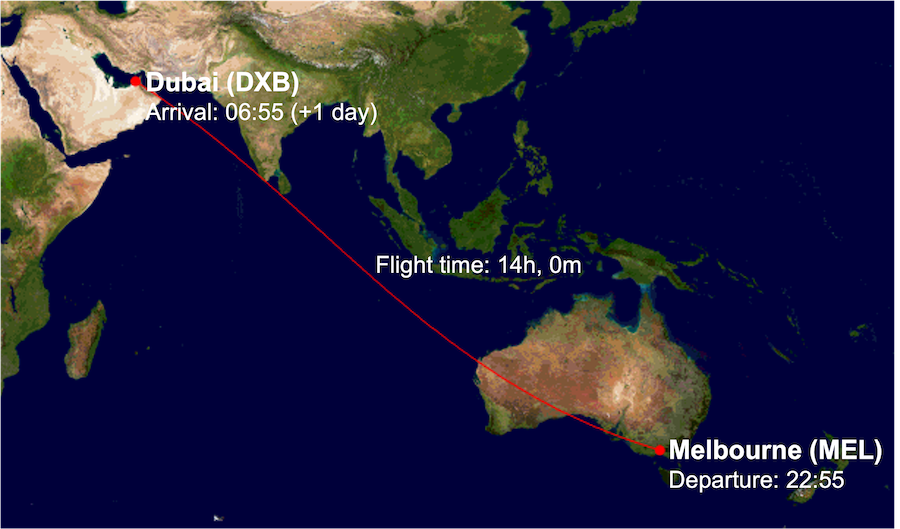
Flight Cost
When searching for flights, I discovered that it was more cost-effective to begin my trip in New Zealand. So, my full itinerary was Wellington-Melbourne-Dubai-Edinburgh, with a stopover in Melbourne. I booked this as a one-way Qantas ticket with “QF” flight numbers, meaning I also earned a decent haul of both Qantas Points and status credits.
In total, this ticket cost me $2,762 (in AUD) one-way. This included a Qantas Business Class flight from Wellington to Melbourne and both Emirates flights (Melbourne-Dubai and Dubai-Edinburgh) in Premium Economy.
At the time of writing, I see that a Premium Economy ticket just from Melbourne to Dubai starts from $2,995 one-way. Alternatively, a Melbourne-Dubai Premium Economy flight would cost 86,000 Emirates Skywards miles + $349 in taxes & charges.
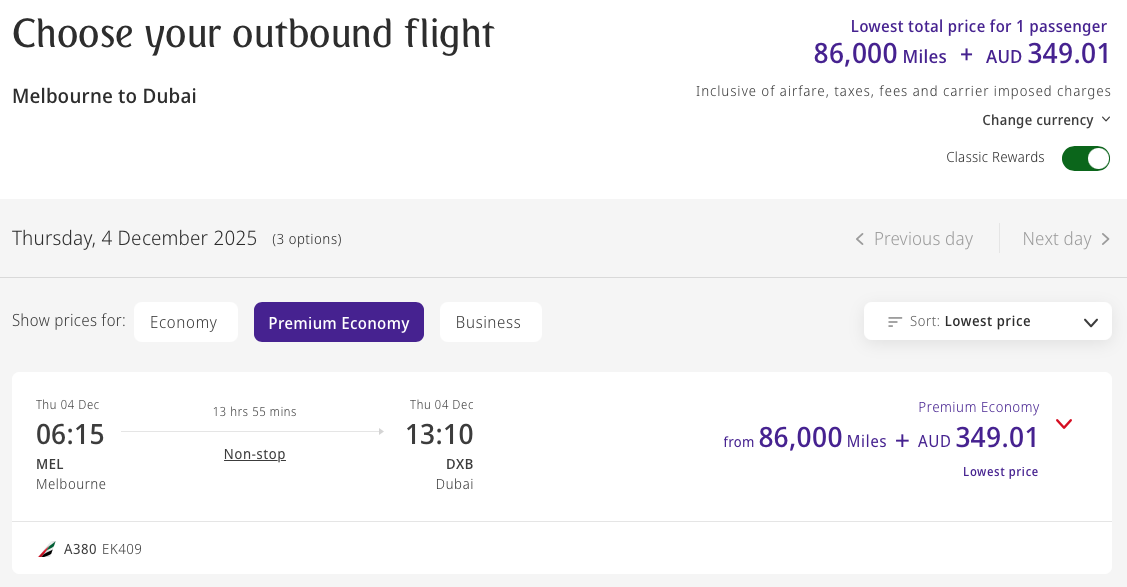
Airport Experience
Most airlines offer a fairly consistent set of inclusions when you buy an Economy or a Business Class ticket. For example – and with some exceptions – you would usually get access to perks like priority check-in, priority boarding, extra baggage allowance and an airport lounge when you book a Business Class ticket.
With Premium Economy, there’s a lot more variation. It’s a relatively new product, and every airline seems to offer different inclusions. Some treat it like Economy Class with a bigger seat, while others treat it more like Business without the flat bed.
One of the biggest areas of inconsistency is with the experience on the ground. A small handful of airlines go as far as offering complimentary lounge access for Premium Economy passengers (Emirates isn’t one of those), while others don’t even have a dedicated check-in line for Premium Economy.
Emirates Premium Economy benefits on the ground
Officially, Emirates provides the following additional airport benefits and inclusions with a Premium Economy ticket:
- Priority check-in
- 10kg cabin baggage allowance (instead of 7kg in Economy)
- 35kg baggage allowance
- Priority boarding in Group C
- Complimentary seat selection
While priority check-in is a nice benefit, in theory, Emirates combined the Premium Economy check-in queue at Melbourne Airport with the online check-in queue. This was full of Economy passengers who had checked in online, so it wasn’t much faster and certainly didn’t feel premium.
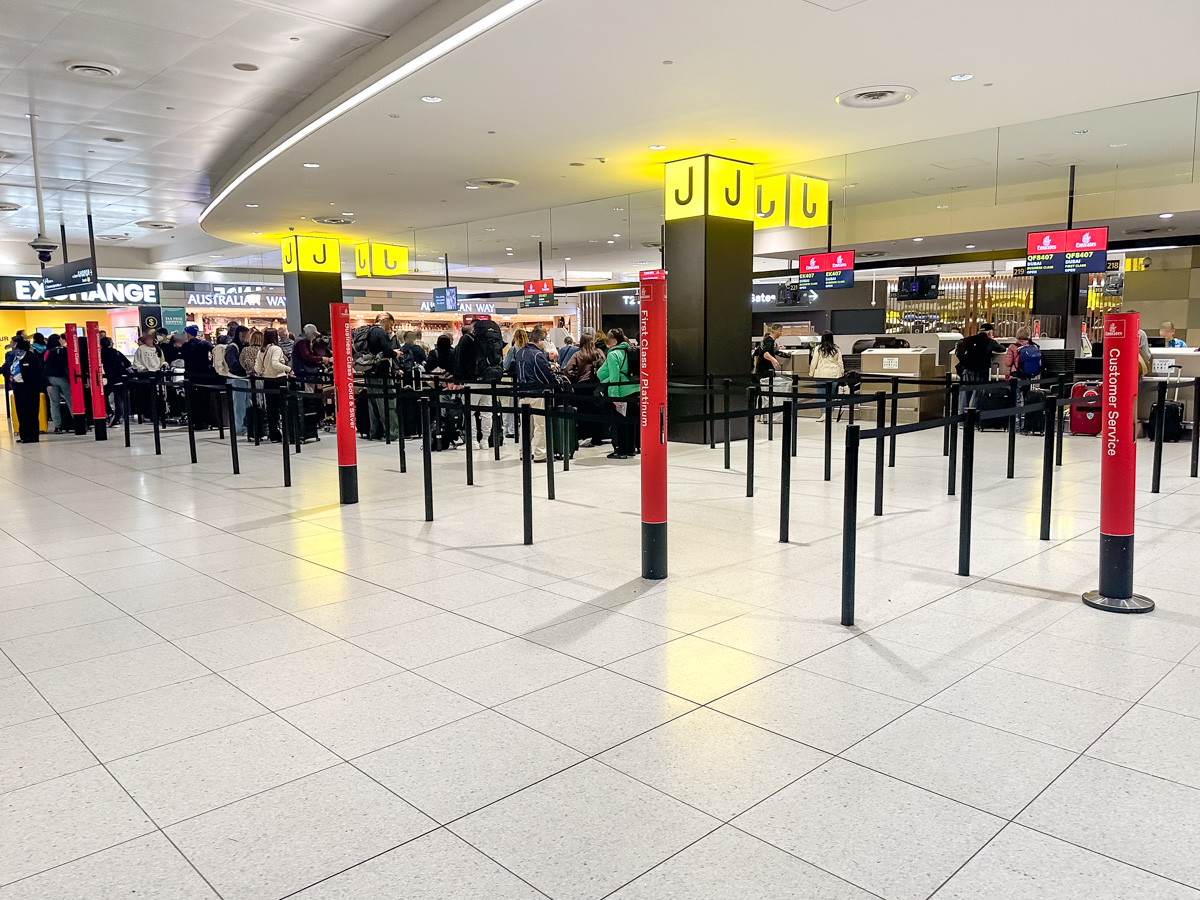
At the gate, there was no dedicated priority boarding lane for Premium Economy passengers. However, I was able to board with Group C, which was called after First and Business Class.
Emirates Lounge access at Melbourne Airport
If you have Gold or higher status with Emirates or Qantas, you would be able to access either the Emirates or Qantas lounges in Melbourne before your flight.
Alternatively, Emirates sells lounge access to Economy and Premium Economy passengers. But it’s not cheap, with paid access to the Emirates Lounge in Melbourne costing USD170.50 (~AU$258) per person! Emirates Skywards members can get a “discounted” price of USD137.50 (~AU$208).
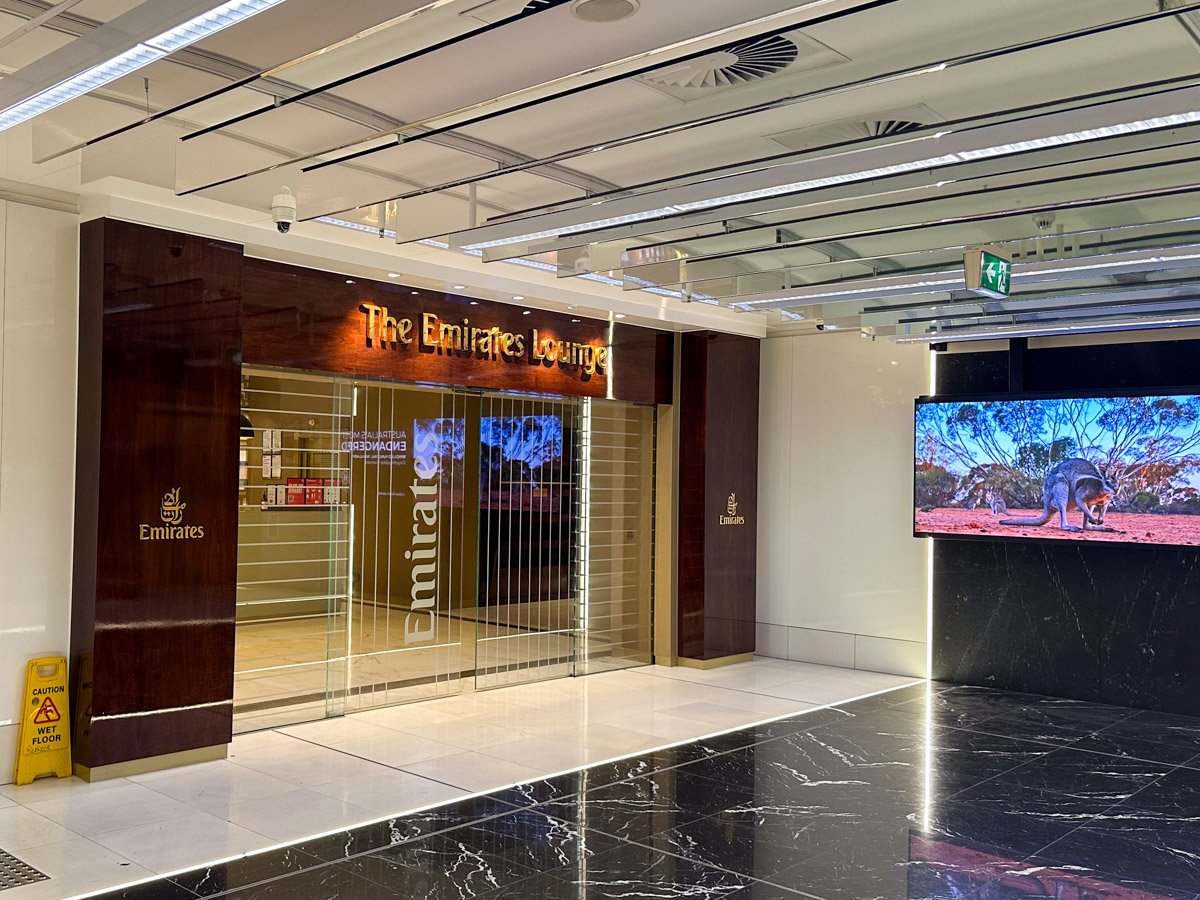
I was able to get into the Emirates Lounge thanks to my Qantas Platinum status, and it was lovely. There was a comprehensive buffet, with proper champagne and premium spirits also available. The lounge was fairly quiet late in the evening, and there were clean toilets and showers available.
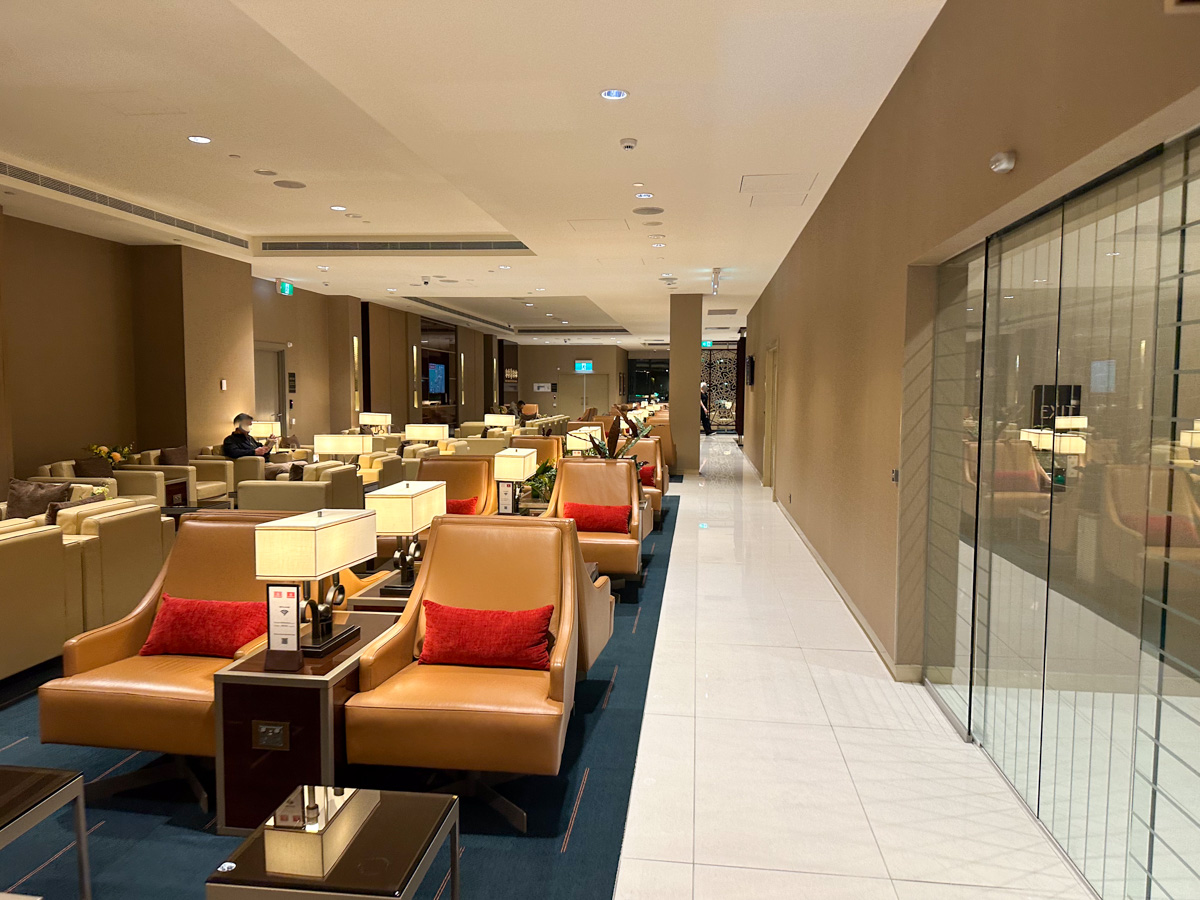
That said, I don’t think it’s worth paying over $200 to get in! If I didn’t otherwise have Emirates Lounge access, I’d consider using Priority Pass or LoungePair to access a different lounge instead.
Since lounge access is not a standard inclusion with an Emirates Premium Economy ticket, I have not taken this into account in my ‘Airport Experience’ rating for this review.
Credit Cards with Priority Pass Lounge Benefits
- Card Name
- Citi Prestige credit card – Up to 200,000 bonus Velocity Points¹
- Earn
- 1
- Signup Bonus
-
Up to 200,000 bonus Velocity Points¹
Apply by 23rd Oct 2025
- Annual Fee
- $700 p.a. ongoing
- Read more
- View Offer
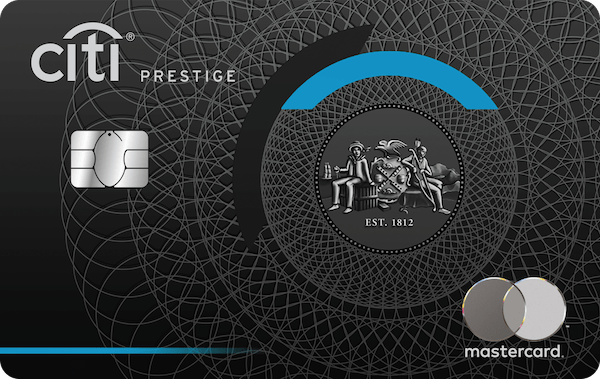
on everyday purchases
- Card Name
- American Express Platinum Card – 200,000 bonus Membership Rewards Points¹
- Earn
- 2.25
- Signup Bonus
-
Receive 200,000 bonus Membership Rewards Points¹
Apply by 2nd Dec 2025
- Annual Fee
- $1,450 p.a.
- Read more
- View Offer
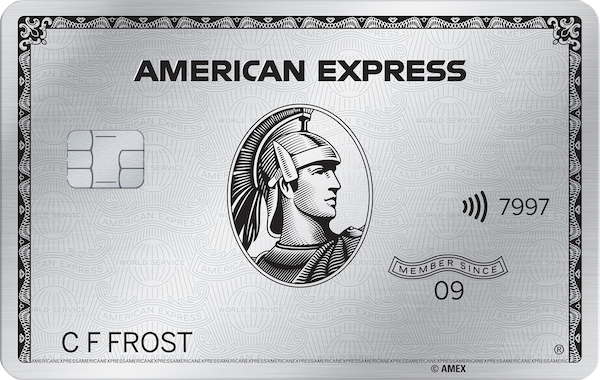
points on everyday purchases
The Hard Product
Emirates has three rows of spacious Premium Economy seats on its refurbished Boeing 777-300ERs, in a 2-4-2 layout. On this particular evening flight from Melbourne to Dubai, 22 of those 24 seats were occupied.
I was travelling with Wilson, the co-host of AFF’s Travel Pointers podcast. We’d selected a pair of seats by the window in row 16, the last row of Premium Economy. (By the way, if you’re interested, we discussed this Emirates Premium Economy journey on episode 17 of the podcast.)
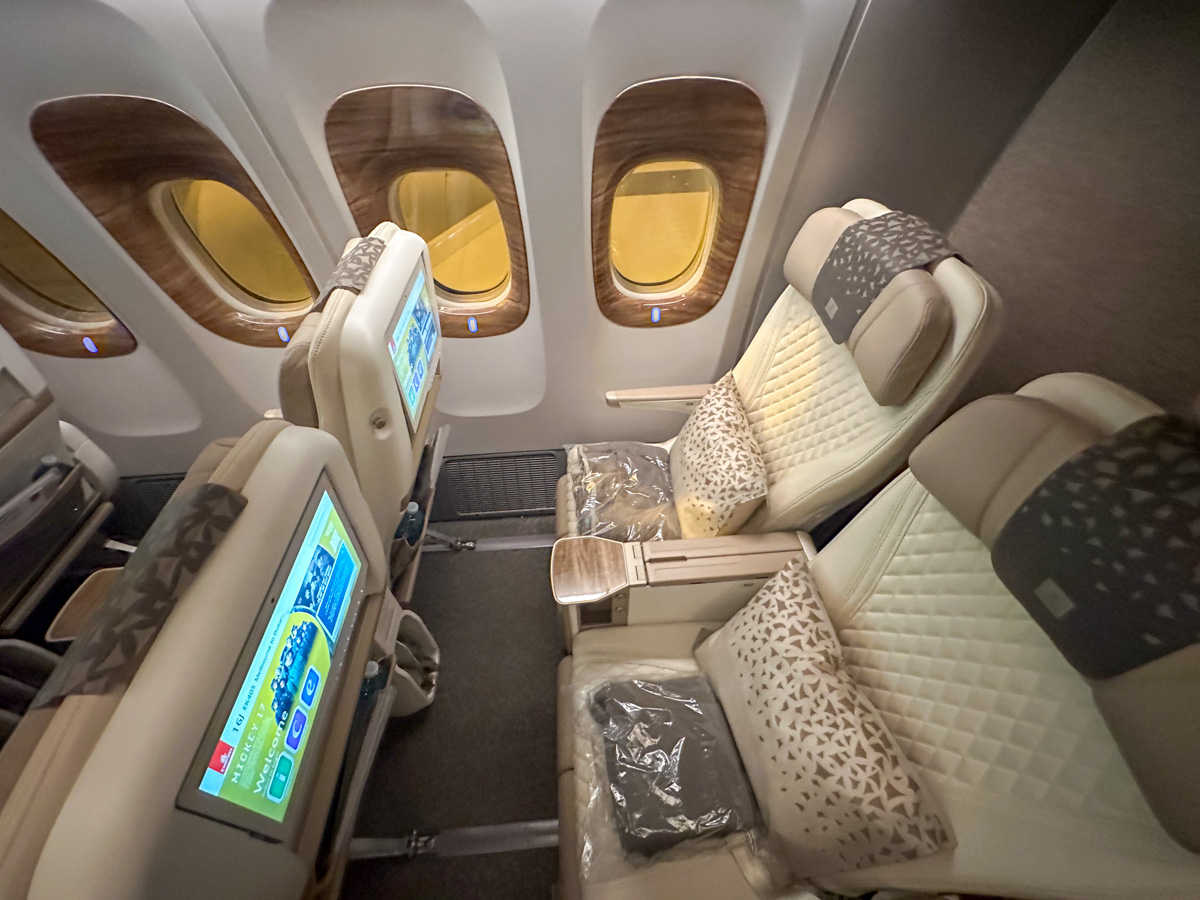
I was very happy with row 16, and with the seat generally. There was nobody sitting behind me, so I could recline guilt-free as much as I wanted. Directly behind my seat was a toilet and galley, so I also couldn’t hear anything from the Economy cabin. The curtain behind Premium Economy also did good job of blocking out any light from the galley.
The toilet behind my seat was one of two dedicated toilets for the Premium Economy cabin. I never had to wait to use it, and it was kept clean and stocked with various amenities throughout the flight.
The plane itself was 8 years old, but seemed newer than that as it had been recently refurbished.
I did, however, notice a slightly bizarre quirk with the overhead panel lights. This part of the plane originally housed Economy seats in a 3-4-3 configuration before the refurbishment, so there were originally three overhead lights installed above our pair of seats.
For some reason, in the refurbishment, Emirates’ engineers removed the light in the middle which actually points at the window seat. This means that, when the person in the window seat turns their light on, it now actually lights up the area between the two seats – which would have previously been intended for the person in the Economy middle seat.
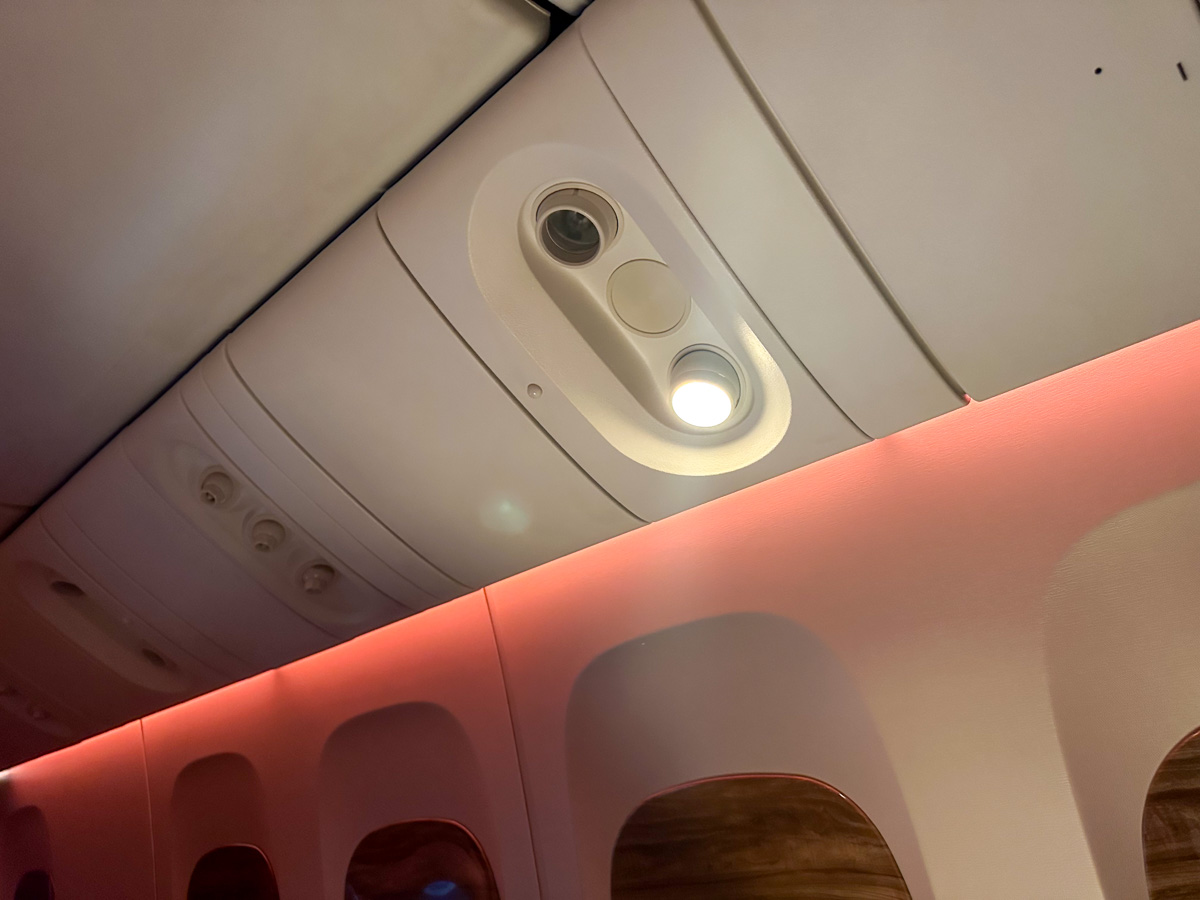
One thing I particularly liked about the cabin was the lovely mood lighting and the fake stars on the ceiling, which appeared during the night. It’s a little touch that sets a nice ambience in the cabin.
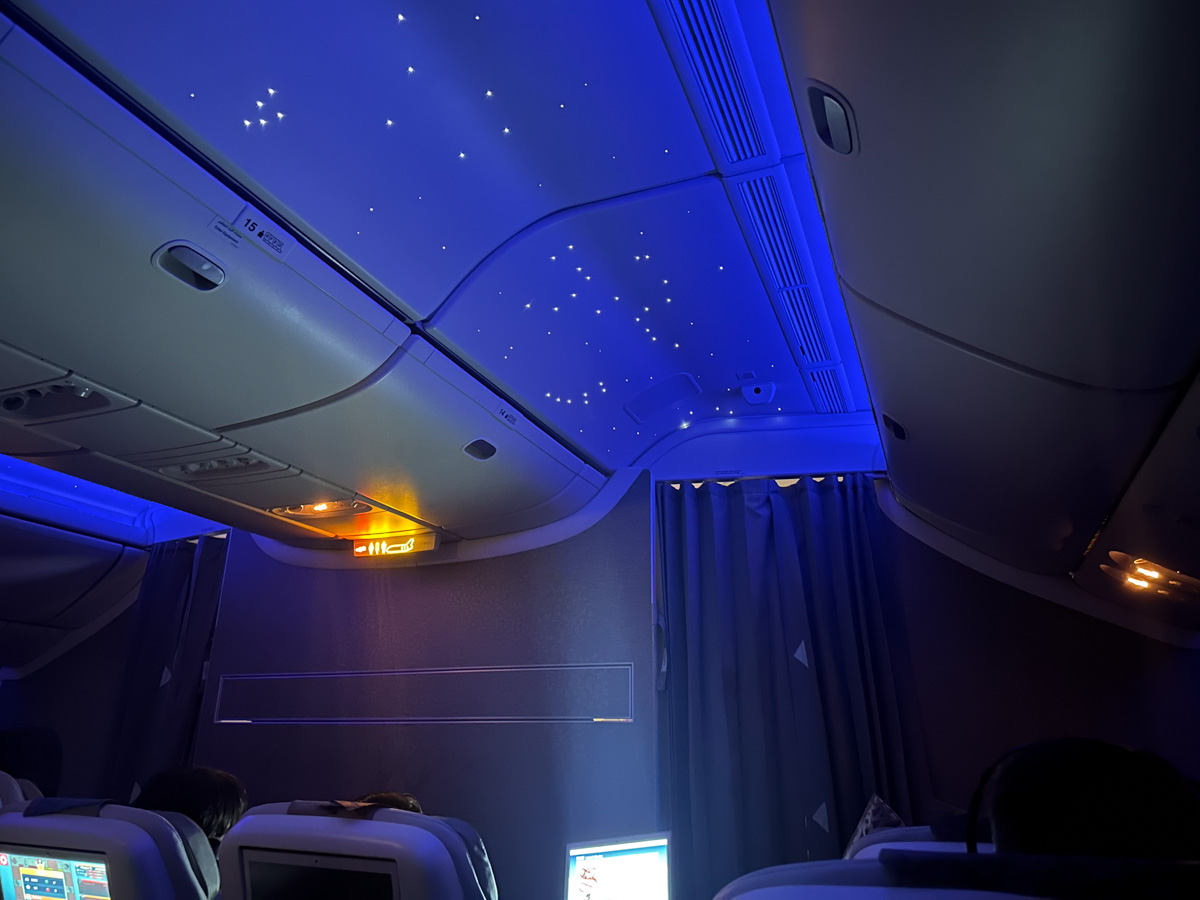
The electronic window blinds were also a neat feature. These open and close in two stages, at the press of a button.
The Emirates 777-300ER Premium Economy seat
Emirates’ version is definitely one of the more comfortable Premium Economy seats that I’ve tested. You get a high-tech, wide leather seat with a good amount of padding and support.
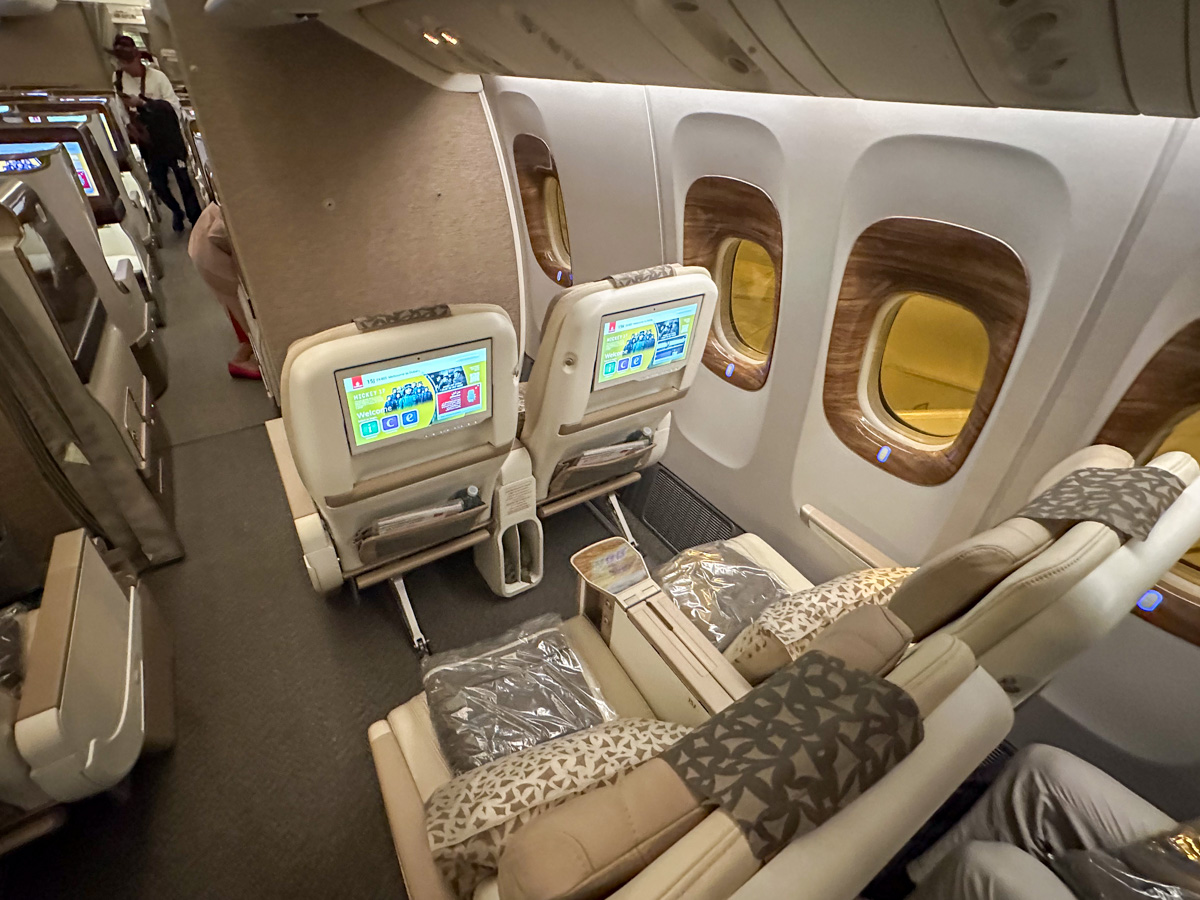
There’s an adjustable headrest that you can fold out to support your head and neck while sleeping. However, if you lean on it, it basically just collapses in onto itself.
I found the legroom to be very good. My knees had plenty of space, and I could fully stretch out my legs underneath the seat in front.
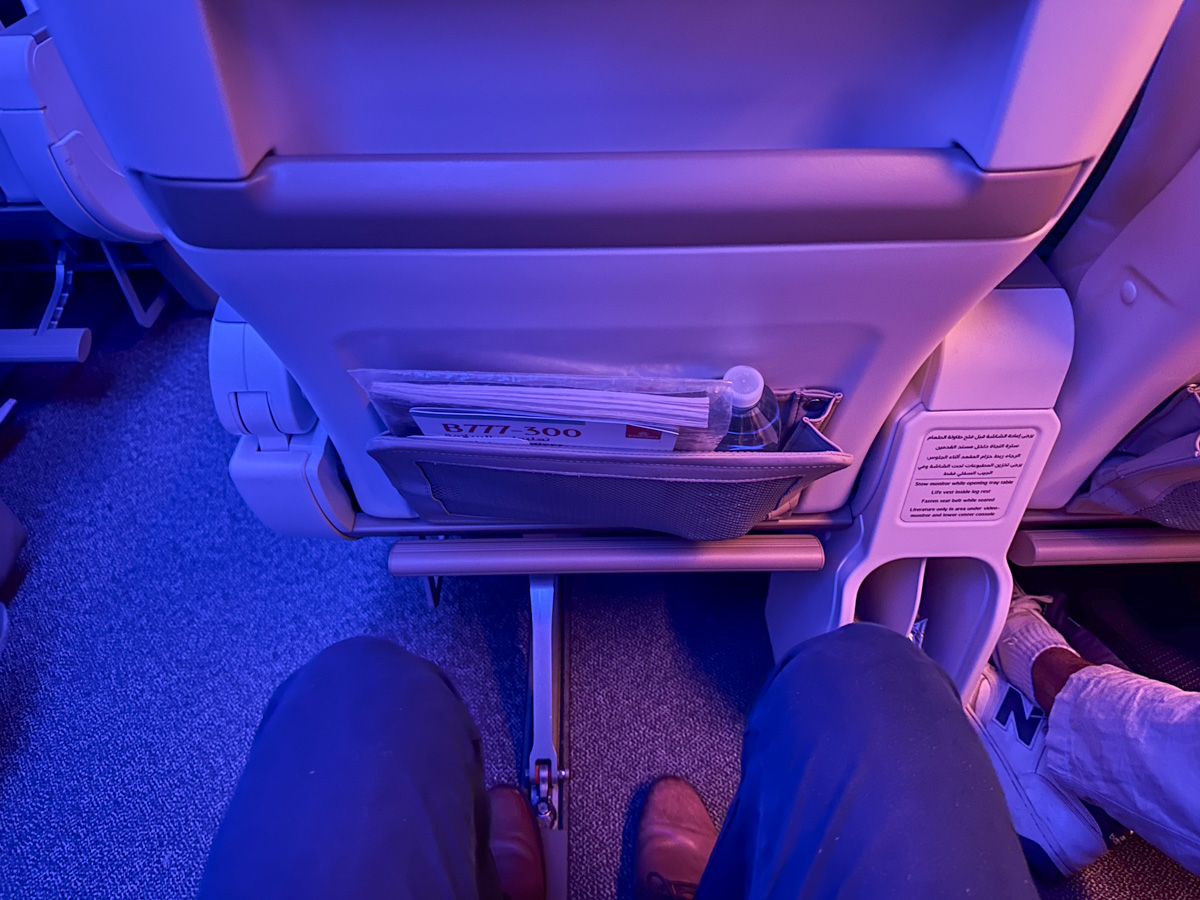
The seat has a fairly deep recline, as well as a fold-out legrest and footrest which I actually found useful. (On many other airlines, I find that the legrests often seem to be designed for people who are much shorter than me!)
Thanks to the generous recline, good legroom and a legrest that actually supported my legs, I managed to sleep on and off for around seven hours during this long-haul overnight flight. Sleep is very important to me, so I’ll take that as a win!
It wasn’t the kind of deeply restful sleep that I might have managed in a lie-flat bed, but I’m sure I wouldn’t have slept as well in Economy. In that sense, Premium economy truly is a “middle ground” between Business and Economy – both in comfort, and in price.
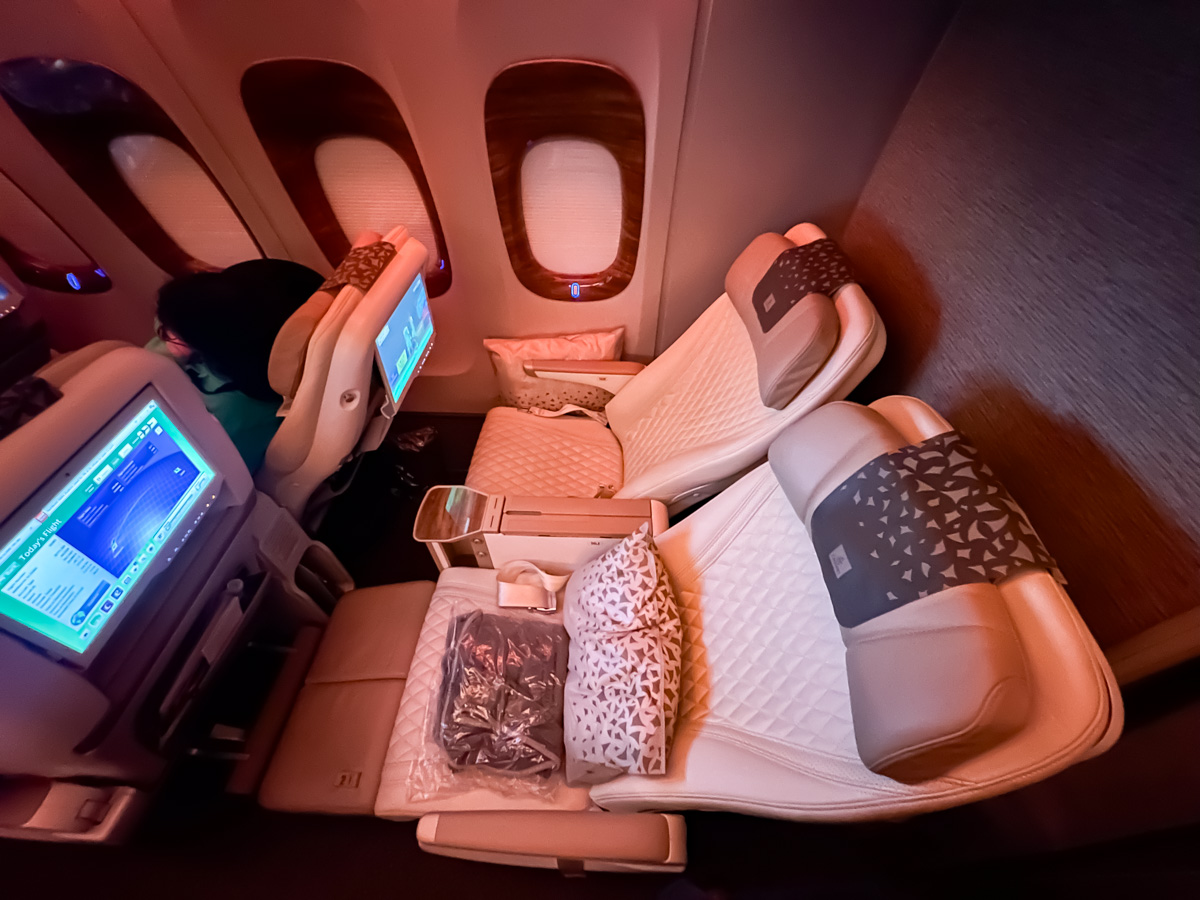
There’s a small cocktail table between the seats. The tray table, which has a nice glossy finish, folds out from under the centre armrest. And there are little extra touches like a coat hook and a small space to store your phone in the side of the seat – although my phone doesn’t actually fit in there.
Overall, this is a fairly luxurious, well-designed seat with good attention to detail. And unlike certain other airlines, Emirates has given the product enough pitch (legroom) to make it work. When the person in front of me reclined their seat, and while my legrest was extended, there was just enough space that my knees weren’t touching the seat in front.
In-flight entertainment & Wi-Fi
There’s a universal power outlet shared between the two seats, as well as USB and USB-C charging outlets on the back of each seat.
On Emirates, the “ICE” in-flight entertainment system really is the star of the show. There’s a large, high-definition TV screen on the back of the seat in front, holding a huge selection of entertainment.
In addition to the extensive library of movies, TV shows, games, podcasts and music, you could even watch live TV (Sport24, Sky News Arabia, BBC News and CNN were all available) or the view from the plane’s external cameras.
The entertainment system also had some neat features, like the ability to simultaneously watch movies or play games with another passenger, set a timer alarm, or even connect to the system with your own bluetooth headphones.
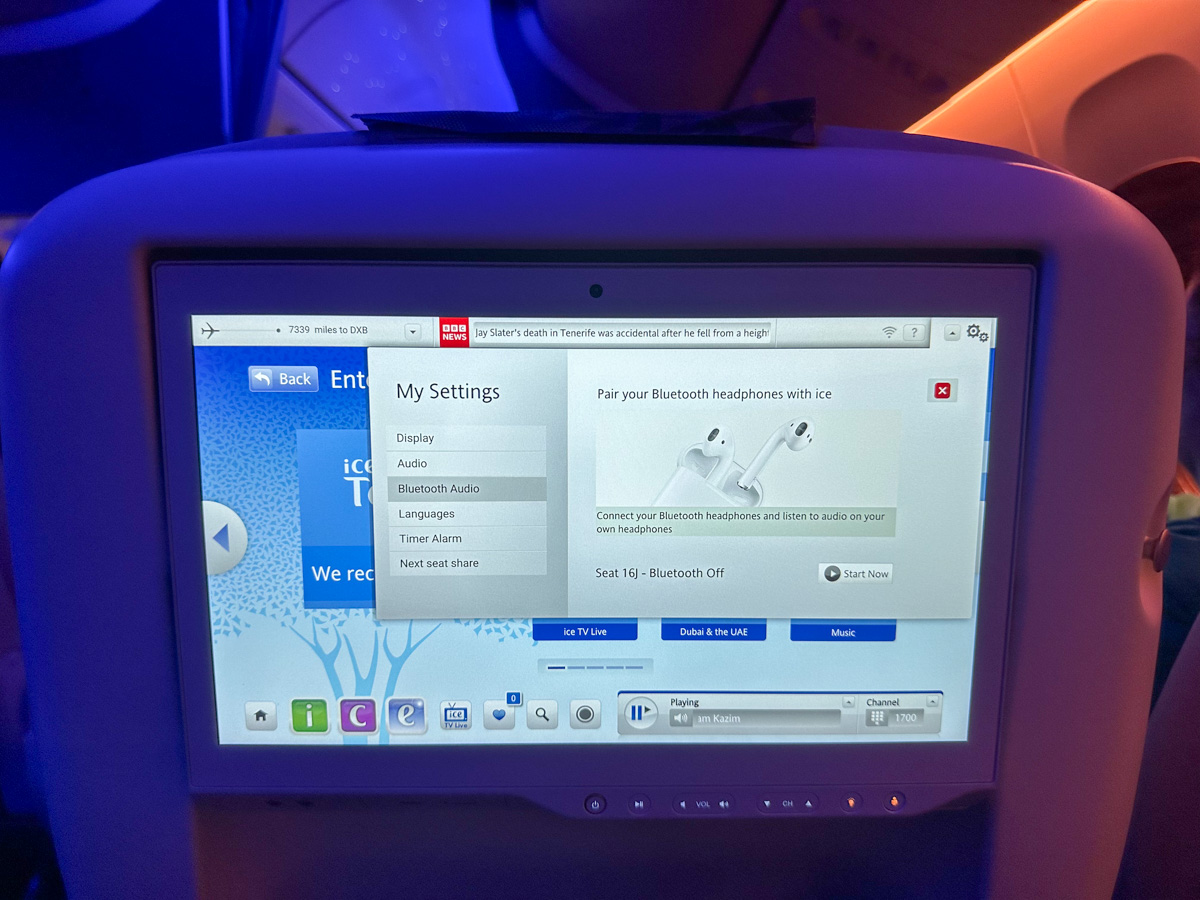
Emirates offers Wi-Fi on board. It’s free if you have an Emirates Skywards number linked to your booking, but I didn’t qualify because I was crediting this flight to Qantas Frequent Flyer. I could have paid USD21.99 (~AU$33) to access the internet for the whole flight.
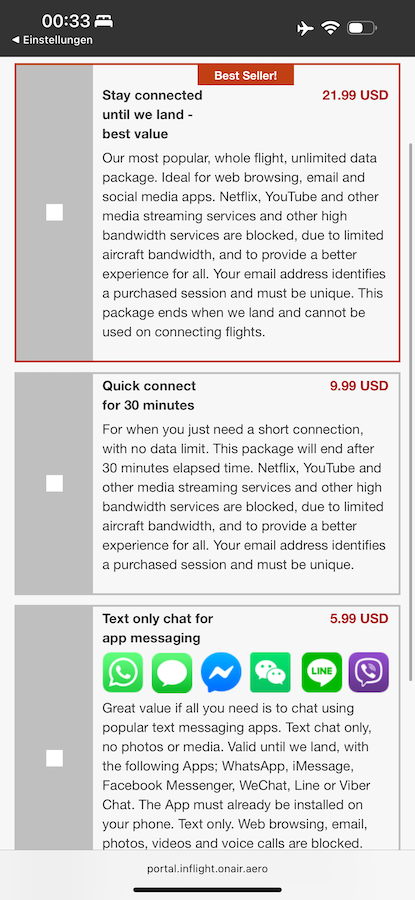
The Soft Product
Overall, the service in Emirates Premium Economy is another clear step-up from Economy – but not quite at the same level as Business Class. Which is exactly what you would expect.
Emirates Premium Economy amenities
When I arrived at my seat, I found a pillow, a blanket, a bottle of water and headphones waiting for me.
While the pillow was large and substantial, Emirates unfortunately skimped on the pillowcase. It was made of a cheap, rough material that I suspect was chosen because it’s disposable. I found the pillowcase pretty awful, to be honest.
The blanket and headphones seemed to be the same as you would get in Economy. The blanket was fine, but I used my own headphones.
The cabin crew also handed out amenity kits to Premium Economy passengers at the start of the flight. This was a fairly basic kit but had a nice design and came stocked with the bare essentials – a toothbrush, socks, earplugs and an eye mask.
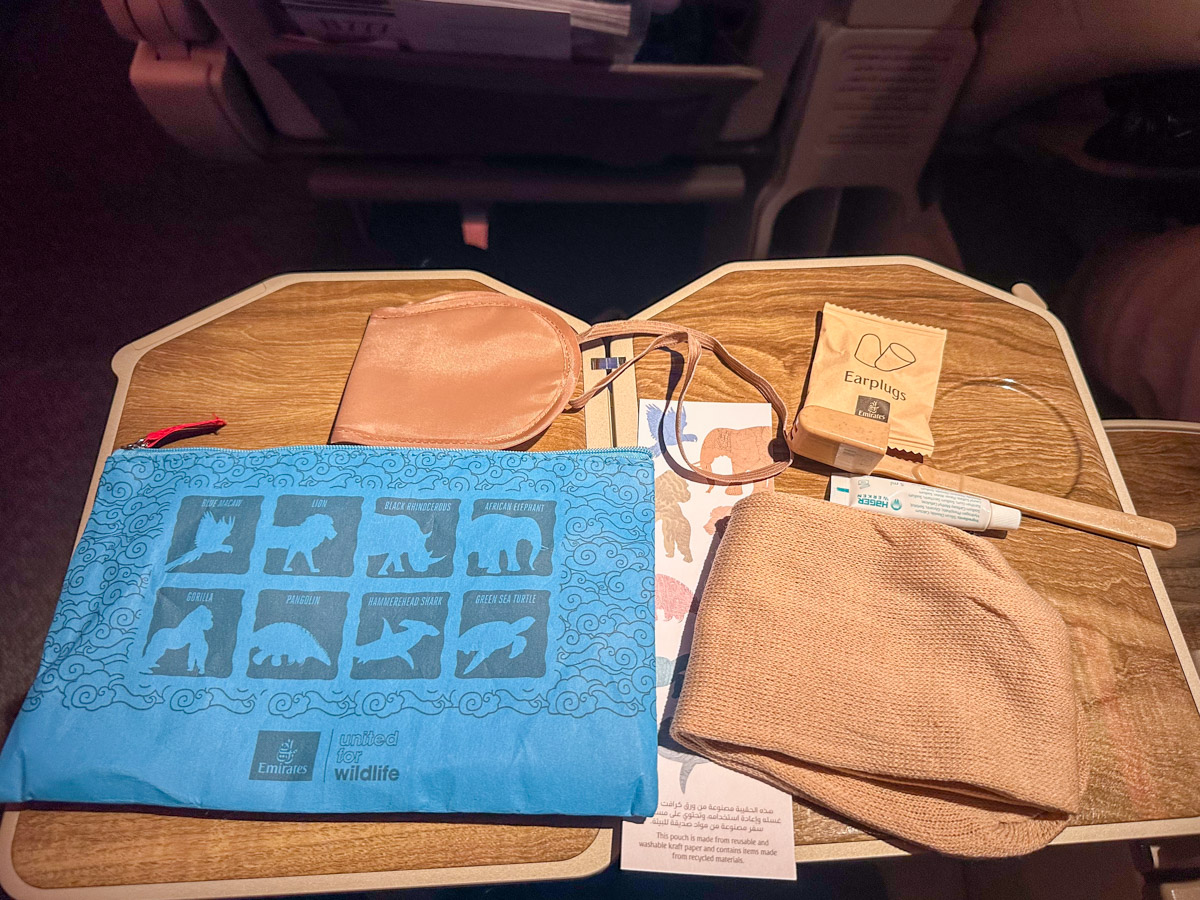
Food & drinks
Before take-off, a flight attendant came around with a tray of non-alcoholic welcome drinks. There was a choice of still water, orange juice or lemon juice, all served in proper glasses. My tip: Go for the lemon juice!
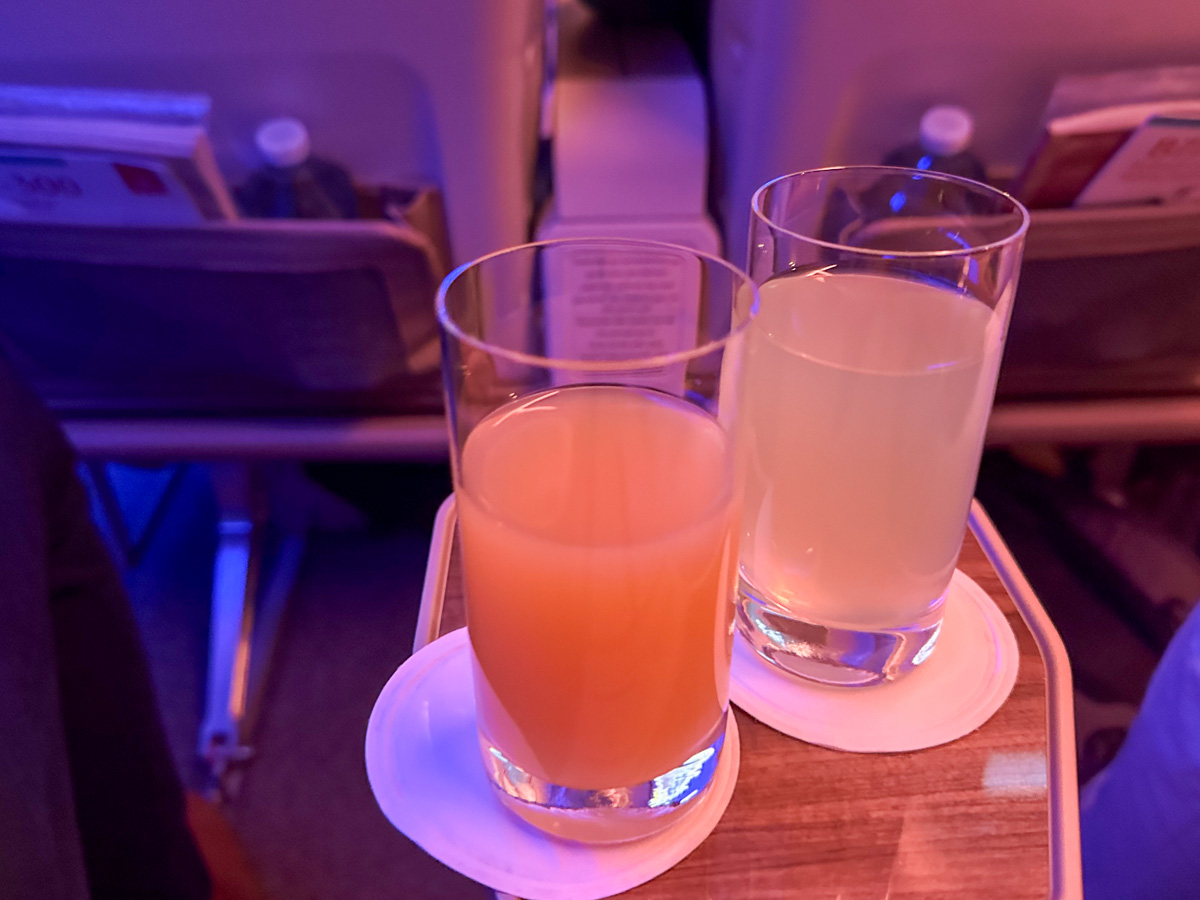
This was followed by a hot towel. After take-off, the crew also distributed printed menu cards.
This was the wine list and the menu for dinner, which was served an hour after departure from Melbourne:
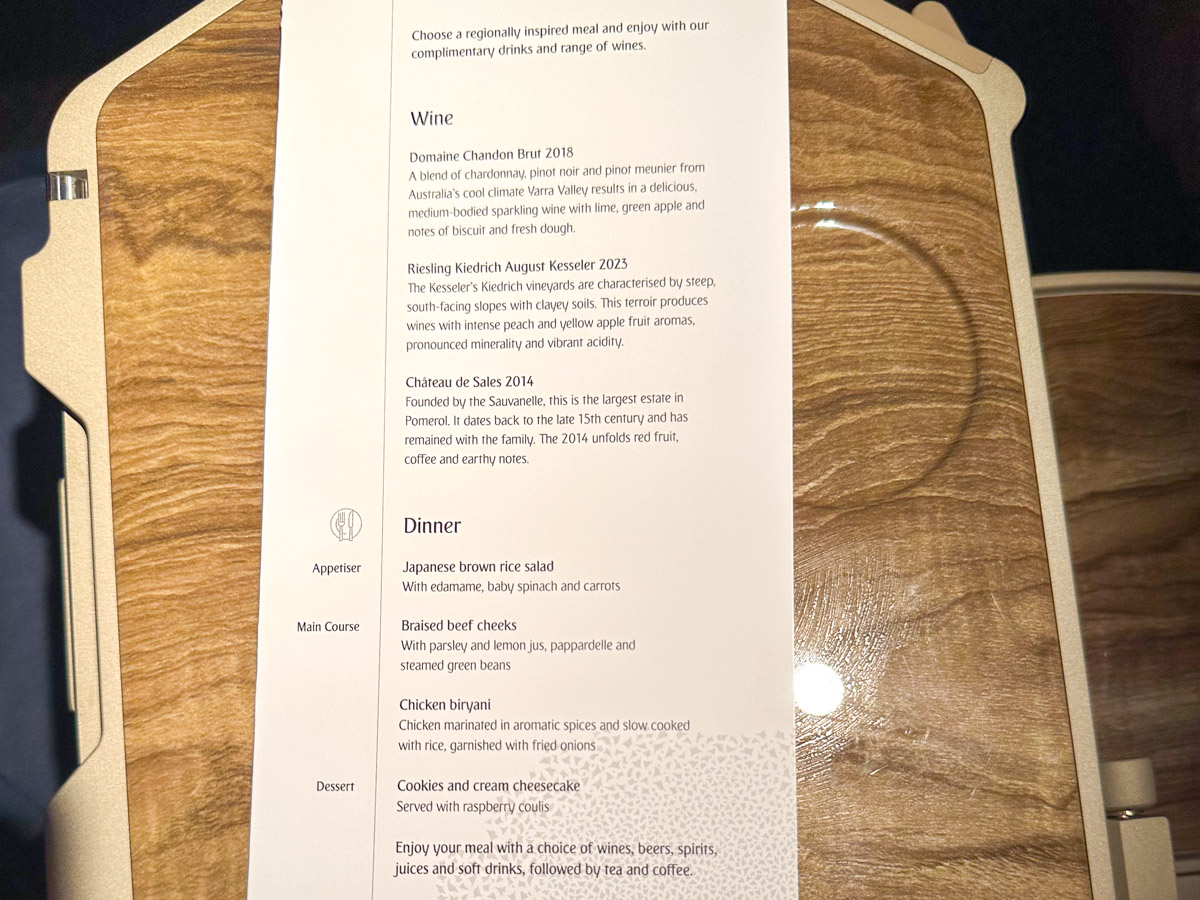
The whole meal came nicely presented on a single tray, with proper crockery, a cloth napkin, glassware, metal cutlery and ceramic salt & pepper shakers. There was even a toothpick. These might seem like simple things, and they are, but they really do add up to make the experience feel more “premium”.
I chose the chicken biryani for dinner, which was really tasty and came with substantial side dishes. The crew also brought around a basket with three types of bread to choose from.
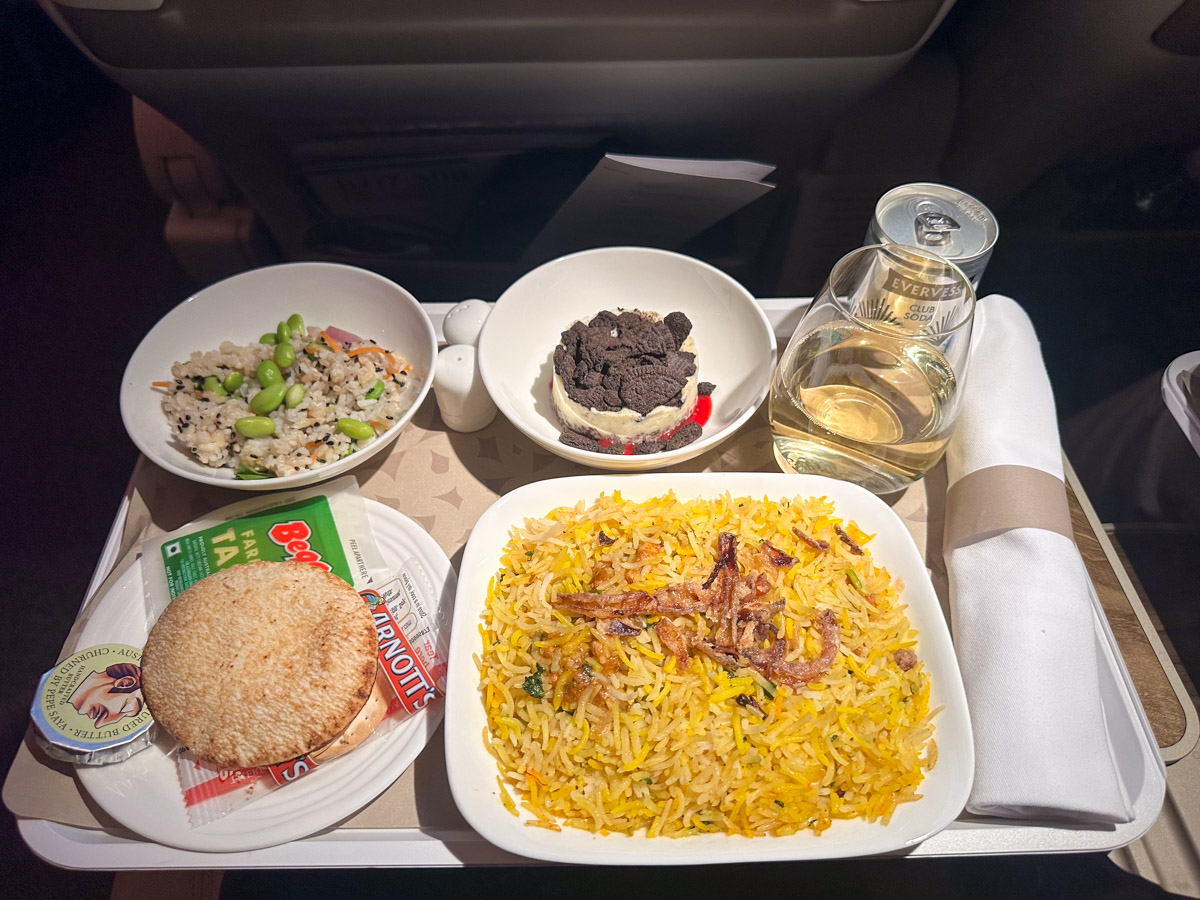
Wilson had the other main course, the braised beef cheeks, which he said was also really good:
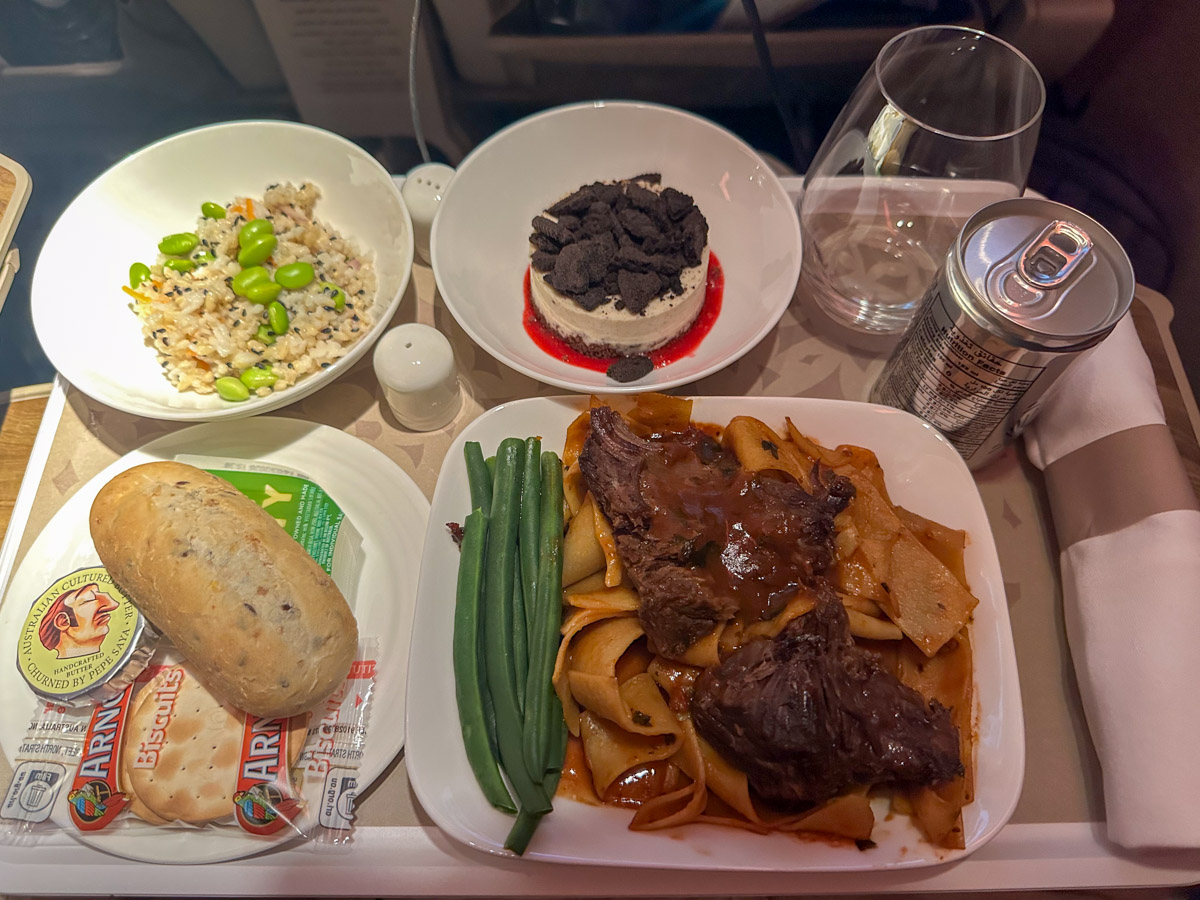
Unlike the extensive wine list you’d find in Emirates Business or First Class, there are just three wines to choose from in Premium Economy: a red, white and a sparkling option. I tried each of the wines and enjoyed them – though it would have been nice if proper champagne was offered. The airline also offers beer and spirits including vodka, gin, rum, whiskey, Baileys and Cointreau.
To end the dinner service, the crew offered tea, coffee and chocolates before switching off the cabin lights.
One thing I noticed is that the crew did not proactively offer drink top-ups. I’m sure you could have got something if you flagged down a flight attendant and asked, though.
I slept through the Light Bites snack service. When I woke up around 4.5 hours out of Dubai, the crew were offering snacks and juice to anyone who was awake.
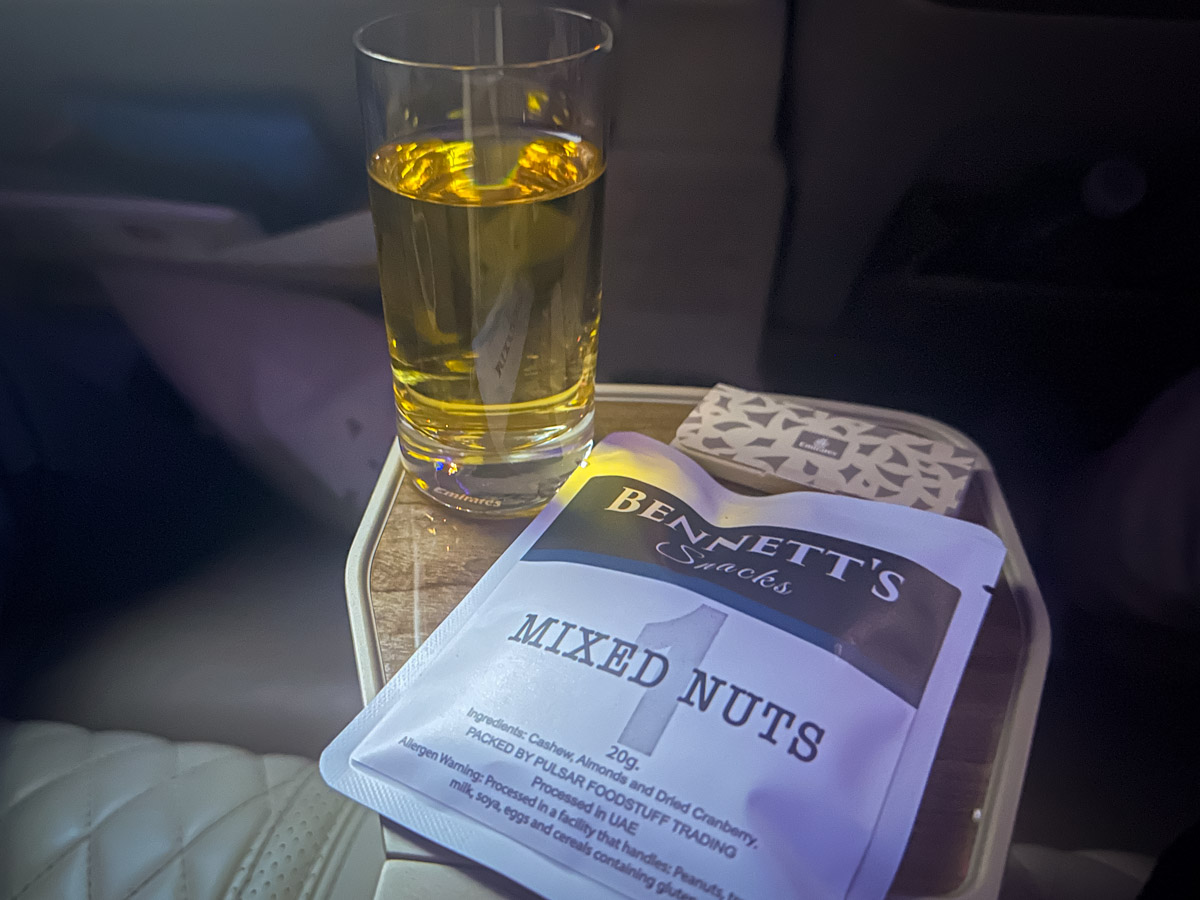
Breakfast came 2.5 hours before landing in Dubai. This was the menu:
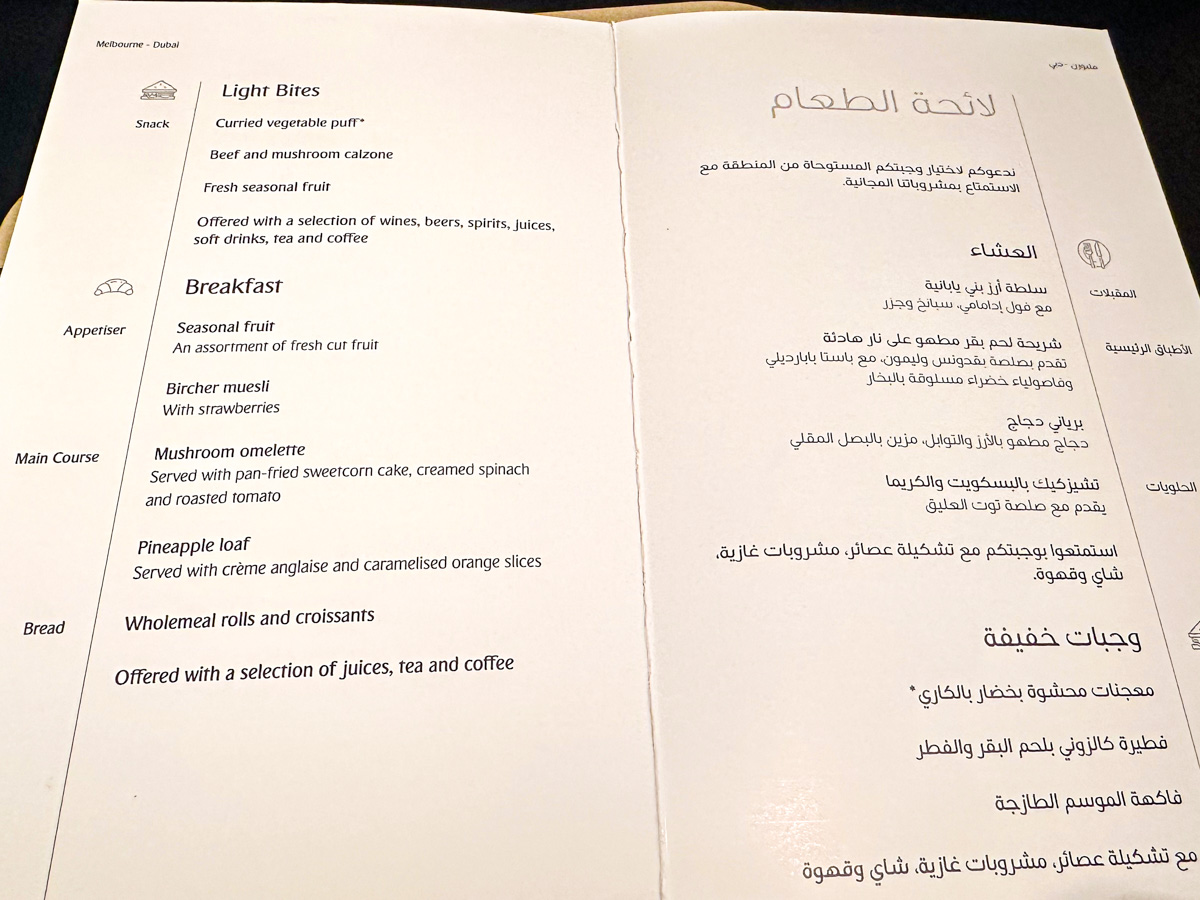
I was happy with the amount of food served for breakfast, and the meal was OK overall. It came with a choice of tea, coffee, orange juice, apple juice or water.
Of the two main course options, I chose the omelette:
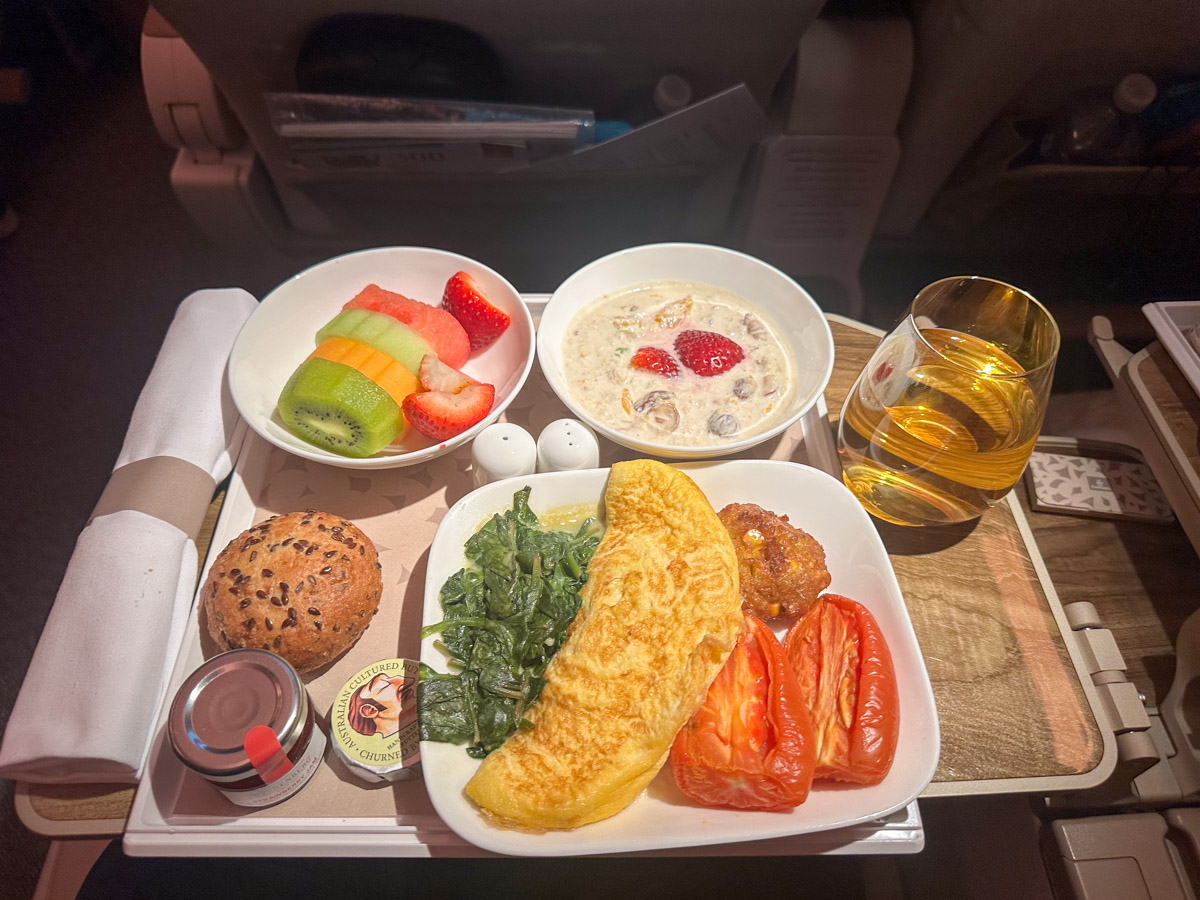
Wilson selected the pineapple loaf, which I thought was a bit of an odd meal to serve on a plane. It was apparently very sweet:
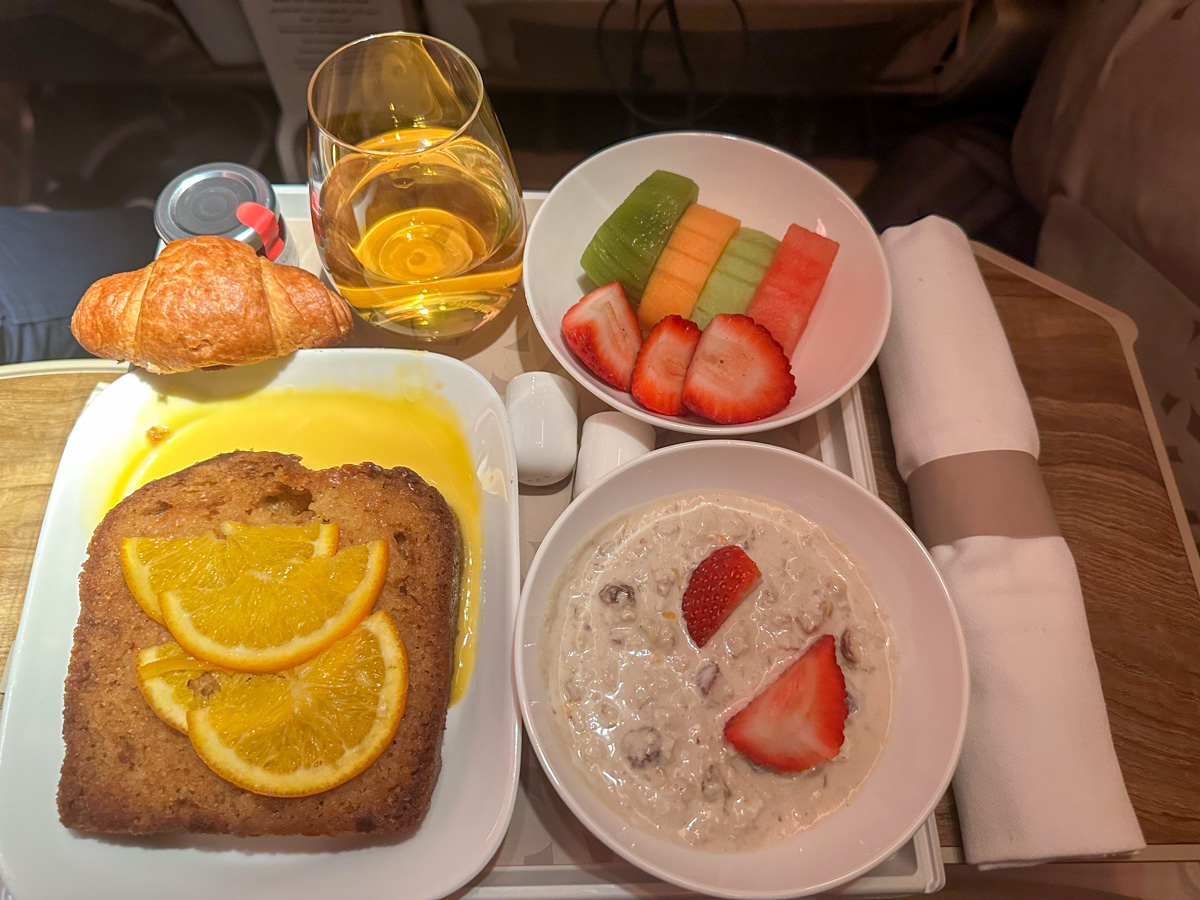
The breakfast service finished with another hot towel, and the crew collected the blankets and headphones an hour before landing.
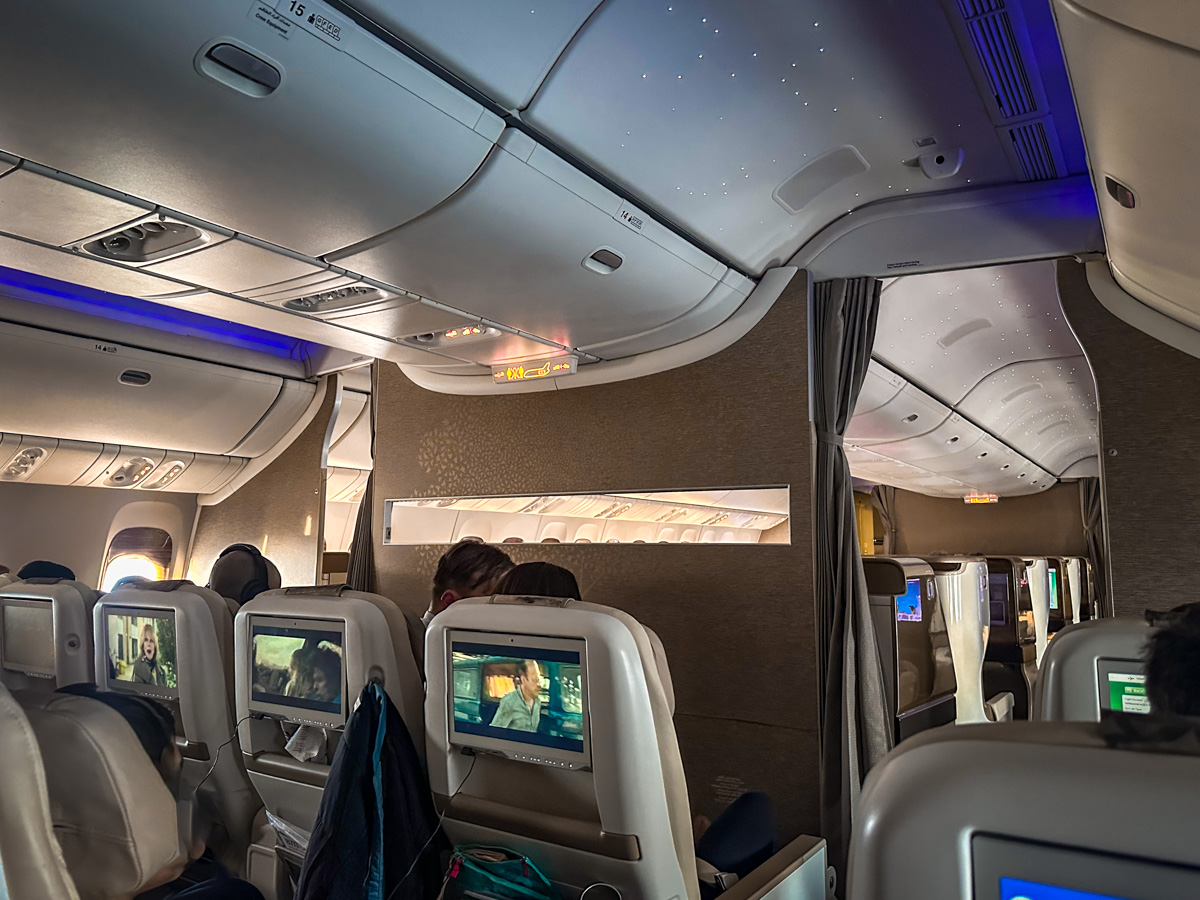
Service
The on-board service in Emirates Premium Economy was friendly and well-intentioned, despite a very slight language barrier at times.
There were a few moments when I felt a bit like I was on an assembly line. But it can also feel like that in Emirates Business Class sometimes, as different crew members are responsible for different things.
Nonetheless, the crew-to-passenger ratio in Premium Economy is really good. There were two flight attendants looking after a maximum of 24 passengers in this cabin.
Emirates Boeing 777-300ER Premium Economy
-
Airport Experience
-
Hard Product
-
Soft Product
Final thoughts
While the benefits on the ground feel a bit spartan, Emirates Premium Economy is a great experience once you’re on board the plane. The seat is very comfortable, and the elevated dining and more personal service is clearly distinguishable from Economy.
Overall, Emirates has a solid Premium Economy product that’s comparable to that of other top airlines. I’d happily fly it again.
But would I choose to pay for Emirates Premium Economy from Australia to Europe again? That would really come down to the price. For a similar price, you would often be able to fly from Australia to Europe in Business Class on a “second tier” carrier and enjoy the comfort of a lie-flat bed.
Admittedly, Emirates offers more convenient one-stop connections via Dubai to many European cities. But I would probably prefer a lie-flat bed for a similar price, even if the trade-off was a longer travel time.
You can leave a comment on the Australian Frequent Flyer forum.
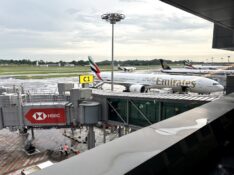
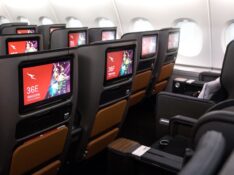
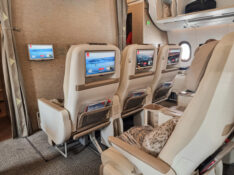
Community Comments
Loading new replies...
Join the full discussion at the Australian Frequent Flyer →